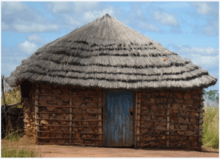Gazebo
A gazebo is a pavilion structure, sometimes octagonal or turret-shaped, often built in a park, garden or spacious public area.[1]
| Look up gazebo in Wiktionary, the free dictionary. |
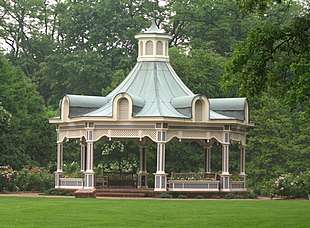
Design
Gazebos are freestanding or attached to a garden wall, roofed, and open on all sides. They provide shade, shelter, ornamental features in a landscape, and a place to rest. Some gazebos in public parks are large enough to serve as bandstands or rain shelters.
Types
Gazebos overlap with pavilions, kiosks,[2] alhambras, belvederes, follies, gloriettes, pergolas, and rotundas. Such structures feature in the literature of China, Persia, and many other classical civilizations. Examples of such structures in England are the garden houses at Montacute House in Somerset. The gazebo at Elton on the Hill in Nottinghamshire, thought to date from the late 18th or early 19th century, is a square, crenelated, brick and stone tower with an arched opening. It acted as a focus for an extensive system of red-brick walled gardens, which has survived with some more modern additions.[3] In contemporary England and North America, gazebos are typically built of wood and covered with standard roofing materials, such as shingles. Gazebos can be tent-style structures of poles covered by tensioned fabric. Gazebos may have screens to aid in the exclusion of flying insects.
Temporary gazebos are often set up in the campsites of music festivals in the United Kingdom, Canada and the United States, usually accompanying tents around it.
A structure resembling a gazebo, found in villages in the Maldives, is known as a holhuashi.[4]
Etymology
The etymology given by Oxford Dictionaries is "Mid 18th century: perhaps humorously from gaze, in imitation of Latin future tenses ending in -ebo: compare with lavabo."[5] L. L. Bacon put forward a derivation from Casbah, a Muslim quarter around the citadel in Algiers.[6] W. Sayers proposed Hispano-Arabic qushaybah, in a poem by Cordoban poet Ibn Quzman (d. 1160).[7]
The word gazebo was used by British architects John and William Halfpenny in their book Rural Architecture in the Chinese Taste (1750). Plate 55 of the book, "Elevation of a Chinese Gazebo", shows "a Chinese Tower or Gazebo, situated on a Rock, and raised to a considerable Height, and a Gallery round it to render the Prospect more complete."
George Washington had a small eight-sided garden structure at Mount Vernon. Thomas Jefferson wrote about gazebos, then called summerhouses or pavilions.
Gallery
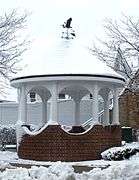 A gazebo during winter, topped with a weather vane
A gazebo during winter, topped with a weather vane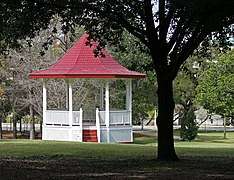 Gazebo in Sam Houston Park, Houston, Texas
Gazebo in Sam Houston Park, Houston, Texas- Gazebo, United States, late 19th century
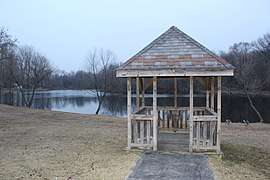 Weathered gazebo near a fishing hole in Fox River Grove, Illinois
Weathered gazebo near a fishing hole in Fox River Grove, Illinois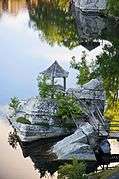
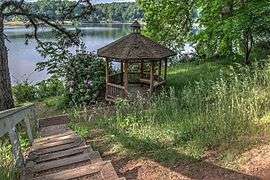 Gazebo at Lake Junaluska, NC
Gazebo at Lake Junaluska, NC.jpg) A two-story gazebo at Ammand Dam, Tabriz, Iran.
A two-story gazebo at Ammand Dam, Tabriz, Iran.
References
- A longer definition appears in the Merriam-Webster Concise Encyclopedia: Retrieved 25 October 2012.
- The word as applied to late medieval structures in Iran and Turkey corresponds to a gazebo. The modern English senses of a street stall or a telephone box do not. Collins English Dictionary: "(in Turkey, Iran, etc., esp. formerly) a light open-sided pavilion."
- British Listed Buildings. Retrieved 25 October 2012.
- Word Finder Retrieved 3 May 2017.
- "gazebo". Oxford Dictionaries. Oxford University Press.
- Bacon, Leonard Lee. "Gazebos and Alambras", American Notes and Queries 8:6 (1970):87–87
- William Sayers, Eastern prospects: Kiosks, belvederes, gazebos. Neophilologus 87: 299–305, 2003.
External links
| Wikimedia Commons has media related to Gazebos. |
- . Encyclopædia Britannica. 11 (11th ed.). 1911. p. 545.
